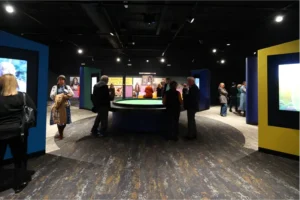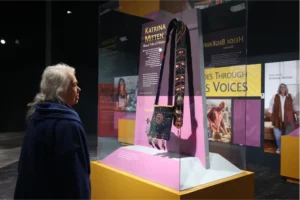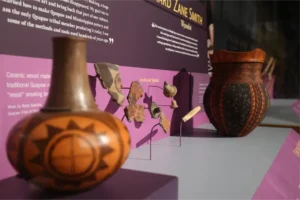Published November 15, 2024
New Experience Open at Angel Mounds
 Visitors can explore the connections between culture and the cosmos at the place where they came together at the newly transformed Angel Mounds State Historic Site.
Visitors can explore the connections between culture and the cosmos at the place where they came together at the newly transformed Angel Mounds State Historic Site.
The $6.5 million project took two years to complete, and the centerpiece is a new interpretive center experience that highlights modern perspectives of native descendants of the Mississippian culture and the special meaning this sacred site has in today’s world. The project was completed in collaboration with artists and historians from federally recognized tribes with strong connections to the historic site, including Miami, Osage, Quapaw and Shawnee nations among many others, and the Indiana University Museum of Archaeology and Anthropology (IUMAA). The project was made possible by $4 million in funding from the state of Indiana and a $2.5 million grant from Lilly Endowment Inc. Lilly Endowment’s support comes through its Religion and Cultural Institutions Initiative, a national initiative supporting organizations as they develop exhibits and public programs that fairly and accurately portray the role of religion and spirituality in the U.S. and around the world.
“We are grateful for the collaborations across many communities that have made this new experience possible,” said Cathy Ferree, president and CEO of the Indiana State Museum and Historic Sites. “The mounds are breathtaking, and now the stories of this vibrant and sacred city are elevated by the voices of living descendants of the Mississippian culture who highlight its relevancy to today’s world.”
Located on the banks of the Ohio River near Evansville, Angel Mounds was a vibrant city that served as a ceremonial and political seat of power for the people of the Mississippian culture from A.D. 1100-1450. Between 1939-64, Indiana archaeologist Glenn Black led a site excavation and uncovered more than 2.5 million artifacts. Angel Mounds was designated a National Historic Landmark in 1964, and it remains one of North America’s best-preserved, pre-European contact Native American sites.
Spanning 600 acres, the historic site includes 11 original earthen mounds built with a special purpose to elevate important buildings in the vast city where people lived, worshiped, worked and grew their food. Today, visitors can immerse themselves in that culture as they explore palisade walls and engage in the stories of the past told by the living descendants of this Mississippian society.
Angel Mounds also highlights the cosmology of the people and their relationship with the cosmos and how everything is connected. Visitors will discover how this community built the mounds to align with certain celestial events, like the summer and winter solstices. The alignment of the mounds also helped them mark the passing of the year, and know when to plant and when to hold ceremonies. These complex alignments designed by the astronomers of their day were recently observed and studied by Indiana University researchers Dr. Edward Herrmann and Dr. William Romain along with museum staff.
“Angel is a wonderful example of preservation that shows the brilliance of indigenous people in North America,” said George Ironstrack, citizen of the Miami Tribe of Oklahoma. “My people didn’t build Angel. My ancestors had similar brilliance and certainly visited that place. I really see a site like Angel Mounds as really important in the future to bring my community to in groups to witness the brilliance of people who were their ancestors’ neighbors. And it can remind them of their own ancestors’ brilliance that is connected to land in a deep and meaningful way and connected to the sky in a deep and meaningful way, in the same ways that we today are revitalizing our own connections to place and to the sky. It’s a really powerful symbol of that.”
Throughout the year, visitors can experience those connections between the sky and Angel Mounds through vibrant videos and images of the Milky Way shown inside the new interpretive center. There, guests can also see the mounds through the eyes, talent and culture of modern descendants.
Traditions of pottery making and creating other forms of art were part of daily life for the inhabitants of Angel Mounds. Today, Native artists take those traditions further by mixing them with their own perspectives. For the new experience, artists from across the U.S. were asked to reflect on what they saw at Angel Mounds and add their own modern twist to create historically inspired artwork. Guests will see those pieces alongside artifacts from the site, which are cared for and held by IUMAA.
“This has been an opportunity of a lifetime; collaborating and communicating with people who are so deeply connected to the site has truly added a modern perspective to the past,” said Indiana State Museum and Historic Sites Director of Archaeology Michele Greenan, who worked directly with historians and artists from federally recognized tribes to help develop this new experience. “I can’t wait for visitors to experience the new center and then go out and see the mounds in a whole new light.” 
Outside the center, visitors can take in the expansive view before heading out to explore the natural beauty on the Angel Mounds loop trail. Along the roughly 4-mile trail, new signs will highlight how the mounds were constructed and how they may have appeared to the people who lived there long ago.
Angel Mounds is open to the public 10 a.m.-5 p.m. Wednesday-Sunday. Admission is $12 for adults, $10 for seniors, $8 for children and free for Indiana State Museum and Historic Sites members.









